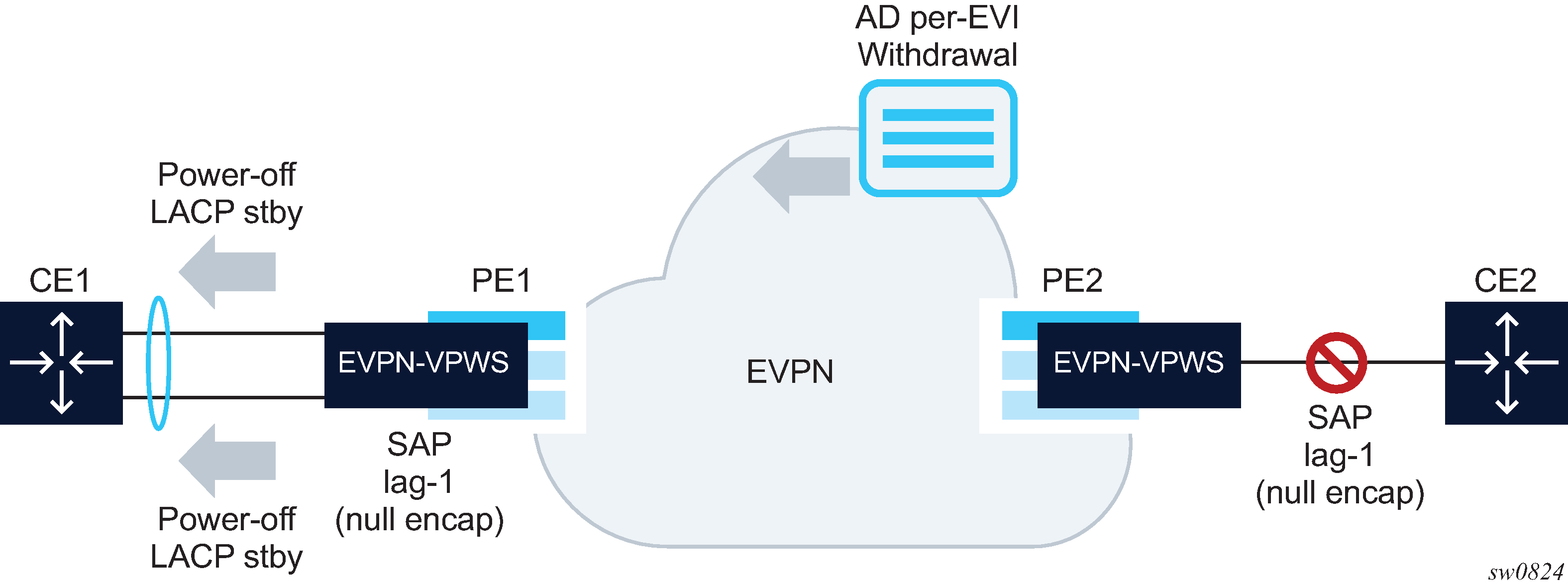SR OS uses Eth-CFM fault-propagation to support CE-to-CE fault propagation in EVPN-VPWS services. That is, upon detecting a CE failure, an EVPN-VPWS PE withdraws the corresponding Auto-Discovery per-EVI route, which then triggers a down MEP on the remote PE that signals the fault to the connected CE. In cases where the CE connected to EVPN-VPWS services does not support Eth-CFM, the fault can be propagated to the remote CE by using LAG standby-signaling, which can be LACP-based or simply power-off.
Figure: Link loss forwarding for EVPN-VPWS shows an example of link loss forwarding for EVPN-VPWS.

In this example, PE1 is configured as follows:
A:PE1>config>lag(1)# info
----------------------------------------------
mode access
encap-type null
port 1/1/1
port 1/1/2
standby-signaling power-off
monitor-oper-group "llf-1"
no shutdown
----------------------------------------------
*A:PE1>config>service>epipe# info
----------------------------------------------
bgp
exit
bgp-evpn
evi 1
local-attachment-circuit ac-1
eth-tag 1
exit
remote-attachment-circuit ac-2
eth-tag 2
exit
mpls bgp 1
oper-group "llf-1"
auto-bind-tunnel
resolution any
exit
no shutdown
exit
sap lag-1 create
no shutdown
exit
no shutdownThe following applies to the PE1 configuration:
The EVPN Epipe service is configured on PE1 with a null LAG SAP and the oper-group ‟llf-1” under bgp-evpn>mpls. This is the only member of oper-group ‟llf-1”.
Note: Do not configure the oper-group under config>service>epipe, because circular dependencies are created when the access SAPs go down because of the LAG monitor-oper-group command.The operational group monitors the status of the BGP-EVPN instance in the Epipe service. The status of the BGP-EVPN instance is determined by the existence of an EVPN destination at the Epipe.
The LAG, in access mode and encap-type null, is configured with the command monitor-oper-group ‟llf-1”.
Note: The configure>lag>monitor-oper-group name command is only supported in access mode. Any encap-type can be used.
As shown in Figure: Link loss forwarding for EVPN-VPWS, upon failure on CE2, the following events occur:
-
PE2 withdraws the EVPN route.
-
The EVPN destination is removed in PE1 and oper-group ‟llf-1” also goes down.
-
Because lag-1 is monitoring ‟llf-1”, the oper-group that is becoming inactive triggers standby signaling on the LAG; that is, power-off or LACP out-of-sync signaling to the CE1.
When the SAP or port is down because of the LAG monitoring of the oper-group, PE1 does not trigger an AD per-EVI route withdrawal, even if the SAP is brought operationally down.
-
After CE2 recovers and PE2 re-advertises the AD per-EVI route, PE1 creates the EVPN destination and oper-group ‟llf-1” comes up. As a result, the monitoring LAG stops signaling standby and the LAG is brought up.